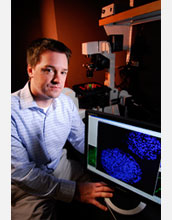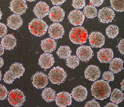|

Discovery
Stem Cell Research Goes Beyond Biology

Todd McDevitt tells how engineering can help us understand stem cell differentiation and develop approaches to realize the potential of stem cells for regenerative therapies
July 17, 2008
Why is an engineer studying stem cells? This is a question I have routinely been asked during my first three-and-a-half years as an assistant professor in the Wallace H. Coulter Department of Biomedical Engineering at Georgia Tech and Emory University. The answer: the field of stem cell research needs engineers to translate the potential of stem cells into regenerative therapies and novel diagnostic technologies for biological sensing and pharmaceutical screening. Today, donated organs and tissues are used to replace ailing or injured tissues, but the need for transplantable tissues and organs far exceeds the available supply. Stem cells, directed to differentiate into specific cell types, offer the possibility of a renewable source of replacement cells to treat many chronic and degenerative diseases including Parkinson's and Alzheimer's diseases, spinal cord injury, stroke, heart disease, diabetes, osteoarthritis, rheumatoid arthritis, muscular dystrophy and ALS (Lou Gehrig's disease). The potential of stem cells is endless--which is why I became increasingly interested in the role of stem cells within regenerative medicine and tissue engineering, as I neared the completion of my doctorate in bioengineering from the University of Washington. As a result of my curiosity, I immersed myself in stem cell biology research during my postdoctoral fellowship in a cardiac pathology laboratory that focused on cell replacement therapies for myocardial repair. During my postdoctoral fellowship, I would often find that the outcomes of my experiments varied dramatically from week to week, even though I followed the same procedures for growing and differentiating the cells. Sometimes my cultures contained many spontaneously and rhythmically beating foci of differentiating cells (evidence of primitive heart muscle formation in a dish), but other times, I strained to find a single area of contracting cells and I was left pondering: "What was different this time?" As an engineer, I was accustomed to controlled systems. The lack of consistency I frequently encountered in my experimental studies while working in this cell and molecular biology laboratory caused me a lot of frustration. General trends and significant differences were clear, but the more subtle changes that frequently seemed to occur went undetected. At the time, I accepted the limitations of the systems we were working with in order to complete my studies and publish the data, but those experiences shaped my views and vision for the future. I began to view stem cell differentiation studies differently. While most investigators studying stem cells were choosing a target cell population a priori and focusing their outcome assessments solely on their ability to obtain a specific cell type of interest, I wasn't. Any instance of failure to differentiate stem cells to a specific cell type represented a potential success in deriving other cell types. This "glass-half-full" perspective suggested to me that global analysis methods are required to truly comprehend how any one stem cell differentiates. Also, if a population of stem cells starts at the same initial point, how do they simultaneously diverge into a broad array of different cell types, and what can be done to improve the homogeneity of differentiation? Now that I am an independent investigator with my own laboratory, I try to address these questions through various research projects. I want to better understand the extracellular environmental cues that regulate stem cell fate and develop engineering approaches to exploit these mechanisms to better control stem cell differentiation. For one project, we are studying how different mixing conditions modulate early embryonic stem cell commitment and subsequent downstream differentiation. To do this, we shake a petri dish of embryonic stem cells in suspension culture at different speeds while the cells are differentiating. We examine how different speeds modify the size, internal morphology and gene expression in "embryoid bodies"--the three-dimensional clumps of embryonic stem cells undergoing differentiation. The results suggest that designing bioreactors to shake at the optimal speed could generate increased yields of desired cell types from embryonic stem cells. In another project, we've developed a method of controlling the presentation of molecules within aggregates of embryonic stem cells to enhance the efficiency and purity of differentiation. Using biodegradable microspheres to release the molecules allows us to control when and where these factors are presented to the stem cells. Engineering the amounts and sequences of certain molecules released from the microspheres may direct differentiation to a specific cell type. We are also examining the molecules that embryonic stem cells spontaneously synthesize during differentiation to see if they can promote tissue regeneration in adult organisms. To do this, we are developing acellular matrices containing these unique factors and assessing their ability to promote tissue regeneration in a variety of wound-healing environments. These studies represent a new application for stem cells that could have broad implications. All of these projects help us better understand the mechanisms regulating stem cell fate and suggest new applications for stem cells to stimulate tissue regeneration. Although we still experience unexplained inconsistencies during the course of our studies because many unknowns remain, the future is bright for stem cell research and particularly for engineers to contribute to translating the potential of stem cells into viable regenerative therapies. -- Todd McDevitt, Georgia Institute of Technology todd.mcdevitt@bme.gatech.edu This Behind the Scenes article was provided to LiveScience in partnership with the National Science Foundation.
Investigators
Todd McDevitt
Related Institutions/Organizations
GA Tech Research Corporation - GA Institute of Technology
University of Washington
Locations
Georgia
Washington
Related Programs
Biomedical Engineering
Related Awards
#0651739 Engineering Control of Embryonic Stem Cell Microenvironments during Differentiation via Integration of Degradable Biomaterials
Total Grants
$275,964
Related Websites
LiveScience.com: Behind the Scenes: Stem Cell Research Goes Beyond Biology: /news/longurl.cfm?id=106
|




